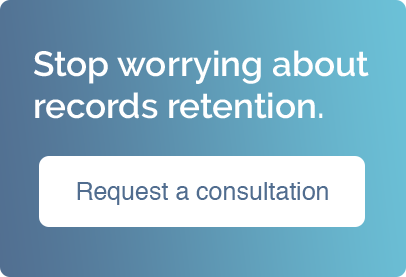4 Tips for Establishing a Data Retention Policy

As a business owner, you are aware that having a data retention policy helps organize all of your business records. Ideally, these documents are stored in groups that support different business operations, regarding both legal and operational retention requirements. Having a data retention policy template to follow helps you create and establish record classes to more accurately track your business records.
Within each class of records kept, you should include a description of the process the records support and examples of the types of records that are contained within that classification. You also want to include the retention period associated with each classification. This period of time can be stated in terms of either months or years. It may also be expressed as being contingent upon the occurrence of a specific event, (i.e., termination of a contract or conclusion of a project). It is also advised that you include a comprehensive legal research document that states the current legal recordkeeping requirements.
As an overarching guideline, businesses and organizations are encouraged to establish consistency in every aspect of record retention. Here are a few guidelines to follow when developing and implementing a record retention schedule.
- Implement a Universal Retention Schedule
Every business unit for a company should be subject to the same retention schedule. This universal retention schedule should be structured in such a way that the classification system categorizes similar or “like” records into broader groups that encourage consistency and manageability.
- Document Retention Periods
When creating a document retention schedule, the retention period listed should reflect the longer period of time between the legal and operational value of the records. The reasoning behind the specific period of time selected should be documented within each group as well. In the case of a legal authority, the legal citations should also be maintained on file and easily accessible.
- Schedule Records for Destruction
Try to avoid calculating specific dates for the destruction of records, as this has an increased likelihood of inconsistency. Therefore, it is recommended, per a data retention policy template, to outline how and when documents should be scheduled for destruction based on a set period of time.
- Review Periodically
Once established, a retention schedule and policy should be considered a dynamic, evolving document. Therefore, you should periodically review your retention schedule. It is recommended that you review this document every 18 to 24 months to determine if any legal research changes regarding retention periods have occurred. This will also give you an opportunity to implement and update the policy to incorporate any internal company changes that were made.
Once you have developed a retention policy for your organization, it is imperative that it be fully implemented. Ensure that every department and those responsible are up-to-date on the latest policy and requirements. Any changes, updates, or revisions should be communicated thoroughly throughout the organization. Working together can help to mitigate differences and maintain consistency throughout the record retention practices in your company.

